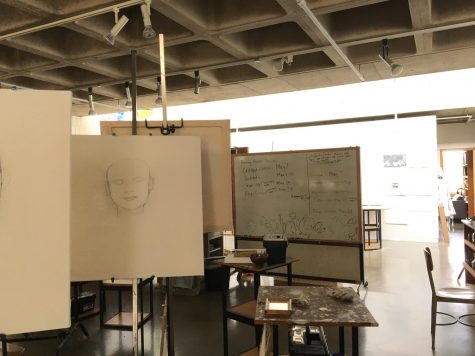In first year, Duvra adds her own touch into the art curriculum
May 9, 2019
This year, Mara Duvra stepped into the role of painting teacher, drawing teacher, sculpture teacher, and printmaking teacher all at once. Taking over after the retirement of longtime Upper School Fine Arts teacher Marty Nash, Duvra describes the new job and the history behind it daunting.
“The person I had just replaced had been at the school for 30 years. That’s a long legacy to step into,” Duvra said.
But Duvra took this task in stride. She started the year with what Nash had done before her.
“The way that I decided to start the semester was starting out initial projects with what had been done before, just sort of carrying some threads through. And then as the semester progressed I started thinking about, what were projects that I would want to introduce? And that comes out more in my second semester of teaching… second semester I was kind of tweaking things in small ways,” Duvra said.
Those changes are not easy, but Duvra has learned to implement her changes in a way that works for her and her students.
“Sometimes [making changes] can be daunting, sometimes people push back, sometimes people don’t like change… You want to make sure that you don’t alienate anybody by just completely uprooting everything and changing everything, because somethings are great and should stay.”
This means Duvra has to be thoughtful of the change she makes and how they are implemented.
“Whenever I’m changing something I’m doing it with a lot of thought I’m not just changing it for the sake of it.”
As for the changes Duvra has made so far, they may seem small but they have a big impact. Her first change was simply in the area the classes take place.
“I made a lot of changes to the studio before I made any changes to the curriculum. I wanted to aerate the space open it up make it feel much more light. And I changed the way that we paint, literally the way we paint, I got rid of the tables. I wanted students to stand, I wanted it to feel like a more active painting environment. All of the painting and drawing classes I’ve had were standing and I think there was a reason for that because it puts you in a different frame of mind and it really focuses your attention in a different way than sitting does,” Duvra said.
She also made changes as she went based on how she felt they went.
“For the first semester I used Ms. Nash’s intro project that was cutting up paper and making collages,” Duvra said. “And as I was doing it I felt like ‘this isn’t a project I would want to continue. It doesn’t feel natural for me to work this way or to engage students in working this way.’ And so I changed it for the next semester.”

Possibly the most crucial of her changes was a shift in critiquing. She used student feedback to make changes to critiques in order to make them more productive and enjoyable for students.
“I’ve changed our format [of critique] and I’ve changed how frequently we critique because I was asking a lot of students ‘have you critiqued? what was the experience for you? what was beneficial? what didn’t you like?’ and a lot of critique for them had felt really long and drawn out. And I think critique can be a process that can produce a lot of ideas and conversations, but it can feel overwhelming. So I just decided to have smaller critiques and have more in process critiques versus just final product critiques because I feel like in process is a way that you’re in the middle of working on this, you can make changes to it, it doesn’t feel like ‘oh I did this whole painting and people don’t like it,’” Duvra said.
As for where she hopes her classes will go, she has a strong idea of what they will look like.
“Some other changes that I haven’t started but that I would like to implement would be talking about art history more so that there’s a context for the things we are making, so that people are not just under the impression that they are making work on an island. Everything you do is influenced by somebody, and someone before you did it, and I want to bring that to light more. I [also] want to incorporate a lot of community aspects, bringing artists in to talk to us and making students feel much more engaged with what’s happening in the gallery,” Duvra said.
Overall, she hopes she can give more meaning to the classes so that students truly gain something from the classes deeper than just art skills.
“My vision for the classes I’m teaching is they become much more rigorous, and by rigorous i mean I want people to feel like they’re really discovering something about making art, and not just making art for the sake of it but like, why are you taking this class? when you leave this class what do you leave with?” Duvra said. “Do you leave with just paintings that you liked or do you leave with ‘oh I never thought I could do something like this.’ I want people to feel that they’ve really spent time working through things that feel difficult but that feel rewarding in the end.”